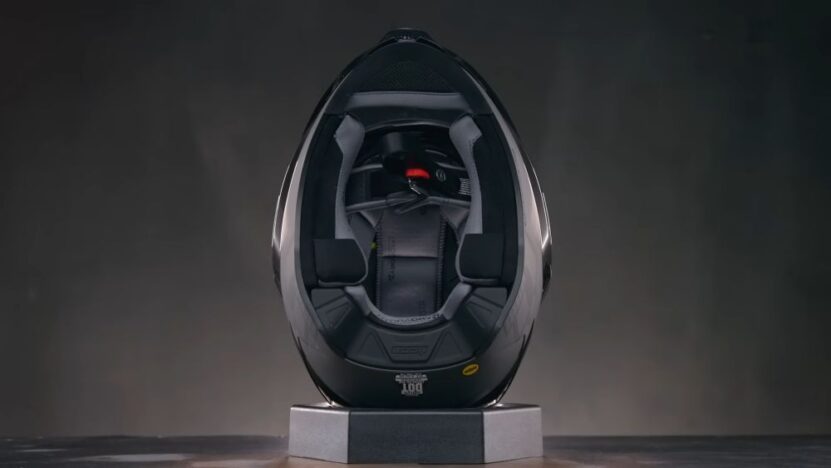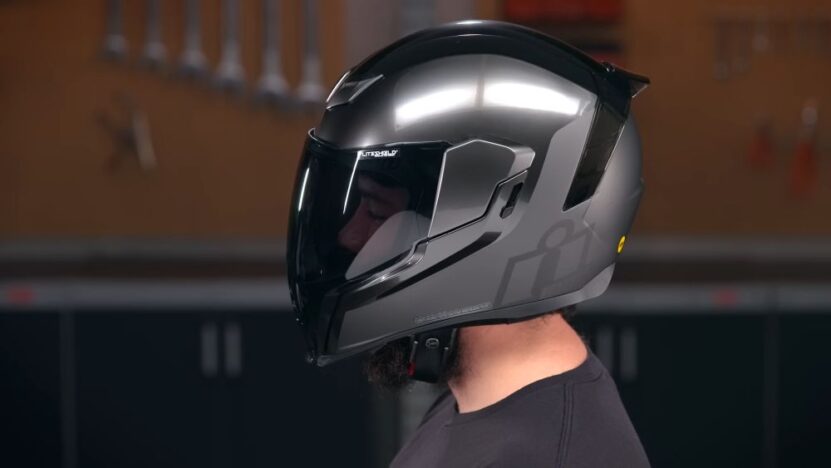There are two main types of motorcycle helmets, full face, and open face. Each has its own advantages and disadvantages, so it’s important to choose the right one for your needs.
Full Face vs Open Face Helmet
The difference between full-face and open-face helmets comes down to safety. Full-face helmets offer the most protection for your head, while open-face helmets leave your face exposed.
Full-face helmets offer the most protection since they cover the entire head and face. They’re also the quietest type of helmet since they seal around the face and prevent wind noise. However, they can be hot in warm weather, and some riders find them claustrophobic. Open-face helmets don’t cover the face, so they’re not as quiet or protective. However, they’re cooler in warm weather and some riders find them more comfortable.
Head Coverage

Head coverage is one of the most important aspects to consider when choosing a helmet. Full-face helmets offer the most protection, covering the entire head, including the chin and jaw. Open-face helmets leave the face exposed and only cover the top and back of the head. Both types of helmets have their pros and cons, so it’s important to choose the one that’s right for you.
Full-face helmets offer the most protection, covering the entire head, including the chin and jaw. This offers the best chance of avoiding serious injury in the event of a crash. However, full-face helmets can be hot and uncomfortable in warm weather, and they can make it difficult to hear traffic around you.
Open-face helmets only cover the top and back of the head. This leaves the face exposed, which some riders prefer for comfort and ventilation. However, open-face helmets offer less protection in the event of a crash, and they also provide less coverage from wind and weather.
Helmet Weight
One key difference between full-face and open-face helmets is weight. Full-face helmets tend to be heavier than open-face helmets, due to their added coverage. This extra weight can be a benefit or a drawback, depending on your needs.
If you’re looking for the lightest possible helmet, an open-face helmet is probably your best bet. However, if you’re concerned about impact protection, a full-face helmet will provide more coverage and may be worth the extra weight.
Portability

Open-face helmets offer better portability than full-face helmets. They are easier to carry and store, and they weigh less. Full-face helmets provide more protection than open-face helmets, but they can be more cumbersome to transport.
Breathability
Full-face helmets offer the most protection for your head, as they cover your entire face. However, this can also make them more difficult to breathe in, as there is less airflow. If you ride in hot weather or do a lot of long-distance riding, a full-face helmet may not be the best choice for you. Open-face helmets don’t cover your face, but they do provide better airflow. This makes them a good choice for riders who want to stay cool and comfortable on longer rides.
Visibility
Full-face helmets offer the best protection for your head, but they can be hot and stuffy. If you live in a warm climate or do a lot of riding in the summer, you might want to consider an open-face helmet. Open-face helmets don’t offer as much protection as full-face helmets, but they’re much cooler and more comfortable to wear.
Comfort

Full-face helmets offer the most coverage and protection, making them the safest option on the market. However, they can also be the heaviest and most constricting, which can make them uncomfortable for some riders.
Open-face helmets provide less coverage than full-face models, but they are typically lighter and more comfortable. This makes them a good choice for riders who want to stay cool and avoid feeling claustrophobic. However, they offer less protection in the event of a crash.
Safety Index
Full-face helmets offer more protection for the face, head, and neck in the event of a crash. They can also be helpful in protecting against the elements, such as wind, rain, and debris. However, full-face helmets can be more difficult to put on and take off, and they can cause discomfort in hot weather.
Open-face helmets offer less protection than full-face helmets, but they are easier to put on and take off. They also tend to be more comfortable in hot weather. However, open-face helmets offer less protection for the face, head, and neck in the event of a crash.
Cost
Full-face helmets provide more protection than open-face helmets since they cover the entire head and face. They also tend to be more comfortable and have better ventilation. However, they can be more expensive due to the extra features they offer.
Open-face helmets provide less protection than full-face helmets but are typically cheaper. They also tend to be lighter and cooler, making them a good choice for hotter climates.
Rider Reference

Full-face helmets provide the most protection for your head, covering your entire face in a hard shell. This type of helmet is ideal if you’ll be riding at high speeds or on rough terrain. Open-face helmets, on the other hand, leave your face exposed.
They’re not as protective as full-face helmets, but they do provide better ventilation and visibility. Open-face helmets are a good choice for riders who want to stay cool and comfortable, or for those who will be riding in urban areas.
Region Suitability
Full-face helmets offer the most protection since they cover the entire head and face. They’re a good choice for riders who frequently ride in chilly or windy conditions, as they help to keep the head and face warm. They’re also a good choice for riders who want the maximum amount of protection possible.
Open-face helmets, on the other hand, don’t cover the face. They’re a good choice for riders who frequently ride in warm weather conditions, as they help to keep the head cool. They’re also a good choice for riders who want to communicate more easily with other people since they don’t cover the mouth.
Full-Face Vs Open-Face Helmet Pros and Cons

Full Face Helmet Pros
- Helps to reduce wind noise and protect your eyes from the elements.
- Provides the most protection for your head It may help to prevent neck injuries
Full Face Helmet Cons
- More expensive than other types of helmets
- Can be hot and uncomfortable to wear in warm weather. It may limit your vision and hearing while riding
- Can be difficult to put on and take off
- It may not be as comfortable as other types of helmets for long rides
Open Face Helmet Pro
- More comfortable than full-face helmets
- Better visibility and less claustrophobic feeling
- Easier to put on and take off
Open Face Helmet Cons
- Less protection for your face in the event of an accident
- Can be noisier than full-face helmets
- Not as aerodynamic as full-face helmets
- More expensive than other types of helmets
- Can be hot and uncomfortable to wear in warm weather
FAQs
Which Helmet Is Better Open Face Or Full Face?
Open-face helmets offer a more traditional look and feel, and tend to be lighter weight than full-face models. They’re also generally more comfortable in hot weather since they provide better ventilation. On the downside, open-face helmets offer less protection than full-face models in the event of a crash.
Full-face helmets offer the most protection since they cover your entire head and have stronger construction. They’re also generally required for racing and more extreme riding activities. However, full-face helmets can be hot and claustrophobic in warm weather and can make it difficult to hear traffic and other sounds.
Is A Full-Face Helmet Overkill?
No, a full-face helmet is not overkill. In fact, it is one of the best ways to protect your head and face while riding a motorcycle. A full-face helmet offers much more protection than a standard motorcycle helmet and can help prevent serious injuries in the event of an accident. So, if you are looking for the best possible protection while riding your motorcycle, a full-face helmet is the way to go.
Is It OK To Use Open Face Helmet?
Open-face helmets provide better visibility than full-face helmets. This can be beneficial when riding in traffic or in other situations where it is important to be able to see your surroundings. They are generally more comfortable to wear than full-face helmets. This is because they do not cover the entire face, which can be beneficial in hot weather or for riders who wear glasses.
However, open-face helmets offer less protection than full-face helmets. This is because they do not cover the entire head and face, leaving the rider’s face exposed to potential injuries. They also tend to be less aerodynamic than full-face helmets, which can make them more difficult to wear for riders who are concerned about wind resistance.
Why You Should Wear A Full-Face Helmet?
There are many reasons why you should wear a full-face helmet when riding a motorcycle. First and foremost, it offers the most protection for your head in the event of an accident. A full-face helmet covers your entire head, including your chin and face, which means that your head is less likely to be injured in a crash. In addition to offering more protection, a full-face helmet also helps to reduce wind noise and protect your eyes from the elements.
When you’re riding at high speeds, the wind can be very loud, so it’s important to have a helmet that will help to reduce that noise. And, if you’re riding in cold weather, a full-face helmet will also protect your face from the wind and cold.
Finally, wearing a full-face helmet just looks cool. It’s the style of helmet that most people think of when they think of motorcycle riders, so if you want to look like a “true” biker, a full-face helmet is a way to go.
Are Carbon Helmets Safer?
Carbon helmets are often lauded for their lightweight construction and impressive strength. They can provide excellent protection in the event of a crash, and they are also very good at dissipating impact energy. However, carbon helmets can be expensive, and they are not as widely available as other types of helmets.
Helmets made from polycarbonate or fiberglass are also popular choices for cyclists. These materials are typically less expensive than carbon, and they are widely available. However, they are not as light as carbon helmets, and they may not provide as much protection in a crash.

